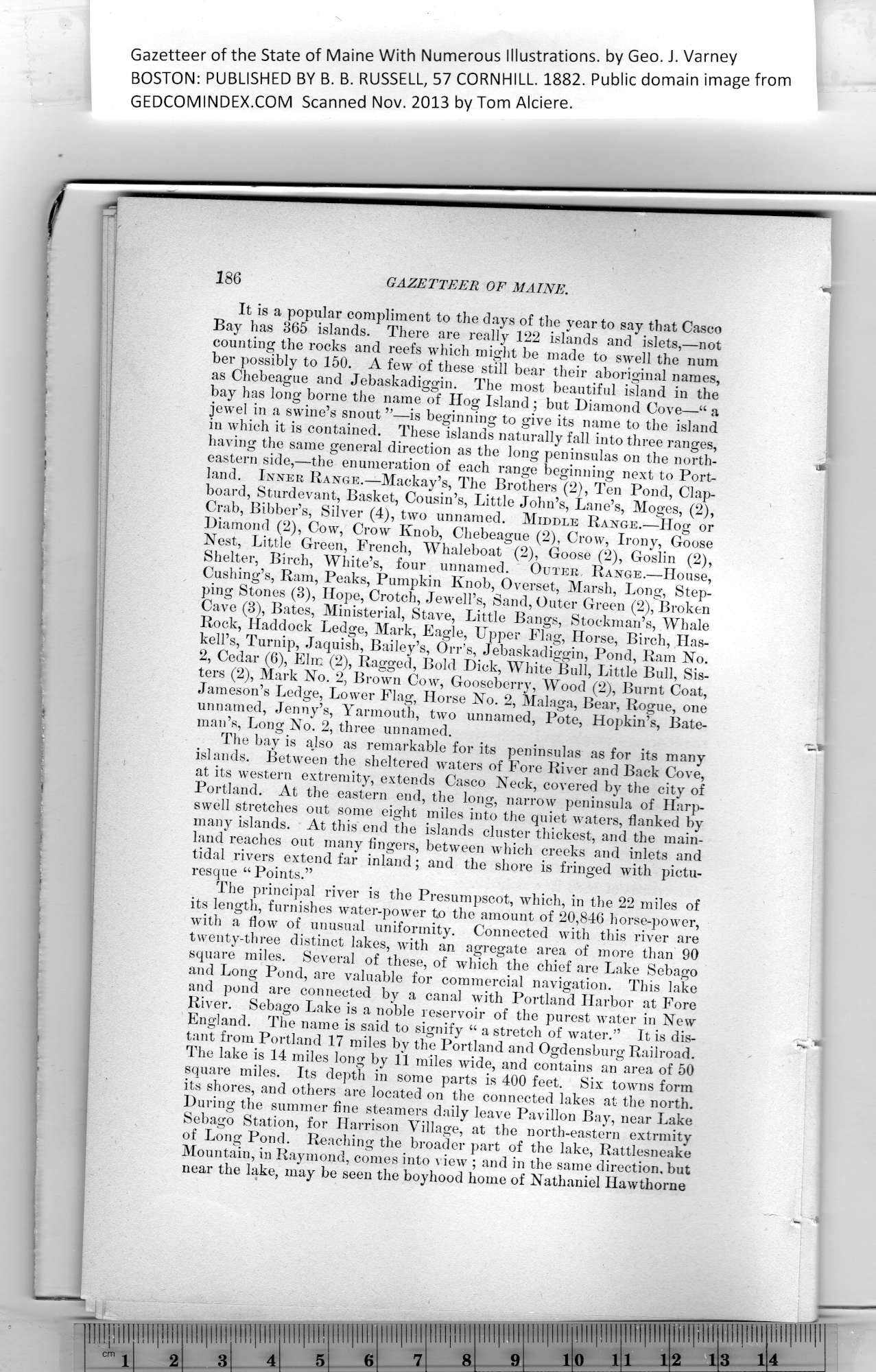|
BOSTON: PUBLIbHtu by d. d. ivjjjlll, .....— ----
186
GAZETTEER OF MAINE.
It is a popular compliment to the days of the year to say that Casco
Bay has 365 islands. There are really 122 islands and islets,—not
counting the rocks and reefs which might be made to swell the num
ber possibly to 150. A few of these still bear their aboriginal names,
as Chebeague and Jebaskadiggin. The most beautiful island in the
bay has long borne the name of Hog Island ; but Diamond Cove—“ a
jewel in a swine’s snout ”—is beginning to give its name to the island
in which it is contained. These islands naturally fall into three ranges,
having the same general direction as the long peninsulas on the north-
eastern side,—the enumeration of each range beginning next to Port-
land. Inker Range.—Mackay’s, The Brothers (2), Ten Pond, Clap-
board, Sturdevant, Basket, Cousin’s, Little John’s, Lane’s, Moges, (2),
Crab, Bibber’s, Silver (4), two unnamed. Middle Range.—Hog or
Diamond (2), Cow, Crow Knob, Chebeague (2), Crow, Irony, Goose
Nest, Little Green, French, Whaleboat (2), Goose (2), Goslin (2),
Shelter, Birch, White’s, four unnamed. Outer Range.—House,
Cushing’s, Ram, Peaks, Pumpkin Knob, Overset, Marsh, Long, Step-
ping Stones (3), Hope, Crotch, Jewell’s, Sand, Outer Green (2), Broken
Cave (3), Bates, Ministerial, Stave, Little Bangs, Stockman’s, Whale
Rock, Haddock Ledge, Mark, Eagle, Upper Flag, Horse, Birch, Has-
kell’s, Turnip, Jaquish, Bailey’s, Orr’s, Jebaskadiggin, Pond, Ram No.
2, Cedar (6), Elm (2), Ragged, Bold Dick, White Bull, Little Bull, Sis-
ters (2), Mark No. 2, Brown Cow, Gooseberry, Wood (2), Burnt Coat,
Jameson’s Ledge, Lower Flag, Horse No. 2, Malaga, Bear, Rogue, one
unnamed, Jenny’s, Yarmouth, two unnamed, Pote, Hopkin’s, Bate-
man’s, Long No. 2, three unnamed.
The bay is also as remarkable for its peninsulas as for its many
islands. Between tbe sheltered waters of Fore River and Back Cove,
at its western extremity, extends Casco Neck, covered by the city of
Portland. At the eastern end, the long, narrow peninsula of Harp-
swell stretches out some eight miles into the quiet waters, flanked by
many islands. At this end the islands cluster thickest, and the main-
land reaches out many fingers, between which creeks and inlets and
tidal rivers extend far inland; and the shore is fringed with pictu-
resque “ Points.”
The principal river is the Presumpscot, which, in the 22 miles of
its length, furnishes water-power to the amount of 20,846 horse-power,
wdth a flow of unusual uniformity. Connected with this river are
twenty-three distinct lakes, with an agregate area of more than 90
square miles. Several of these, of which the chief are Lake Sebago
and Long Pond, are valuable for commercial navigation. This lake
and pond are connected by a canal with Portland Harbor at Fore
River. Sebago Lake is a noble reservoir of the purest water in New
England. The name is said to signify “ a stretch of water.” It is dis-
tant from Portland 17 miles by the Portland and Ogdenshurg Railroad.
The lake is 14 miles long by 11 miles wide, and contains an area of 50
square miles. Its depth in some parts is 400 feet. Six towns form
its shores, and others are located on the connected lakes at the north.
During the summer fine steamers daily leave Pavilion Bay, near Lake
Sebago Station, for Harrison Village, at the north-eastern extrmity
of Long Pond. Reaching the broader part of the lake, Rattlesneake
Mountain, in Raymond, comes into view ; and in the same direction, but
near the lake, may be seen the boyhood home of Nathaniel Hawthorne
PREVIOUS PAGE ... NEXT PAGE
This page was written in HTML using a program written in Python 3.2
|
